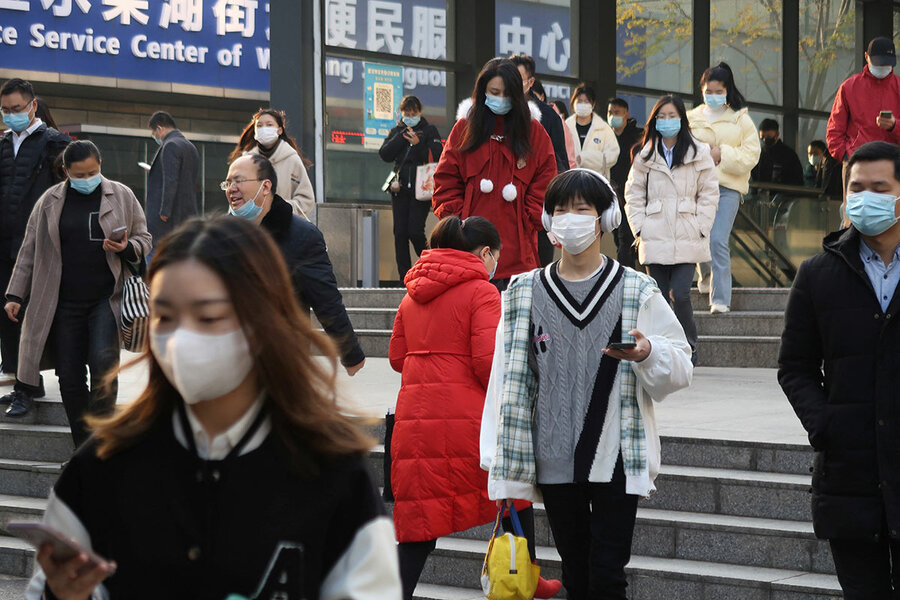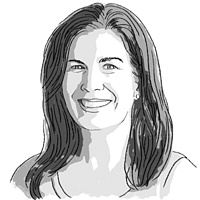From fear to self-reliance: Behind China's COVID-19 shift
Loading...
| Beijing
As Beijing’s leaders make an abrupt shift towards relaxing COVID-19 controls, official messaging around the pandemic has started encouraging self-reliance.
“In the past three years, the virus has weakened but we have grown in strength,” the Communist Party mouthpiece People’s Daily said in a commentary on Thursday, a day after authorities rolled out a new, 10-point COVID-19 plan. These measures mark the biggest nationwide easing of the “zero-COVID” strategy yet, giving people greater leeway to decide if and when they get tested, and to care for themselves if they become ill.
Why We Wrote This
A story focused onUntil this week, China’s COVID-19 policy was based on frightening citizens into accepting tight restrictions. Now, it’s the citizens’ responsibility to decide many things for themselves. The switch from fear to self-reliance, while broadly welcomed, comes at a cost.
Overnight, people are being advised not to worry and, essentially, to fend for themselves – a head-spinning change for a population living in a steady state of anxiety from mass testing, constant health surveillance, and the ever-present risk of draconian lockdowns.
The change comes with greater uncertainty, particularly about the future of China’s large and vulnerable elderly population, but many embrace the new responsibility.
“The adjustment is a bit of a sharp turn,” says Mr. Tian, a construction company worker in Beijing who asked to withhold his first name. “This is not as scary as what [Chinese experts] exaggerated before.”
Until last week, China’s leaders and propaganda machine were using fear-provoking, militaristic language to frame the country’s strict, “zero-COVID” strategy, vowing to “annihilate” the epidemic, win the war, and save the nation from an “unimaginable” death toll. Armies of pandemic workers in white hazmat suits – party cadres, police, medical staff, and volunteers – performed heroic feats each night on television news, protecting residents and meeting their every need.
But as Beijing’s leaders this week made an abrupt shift towards relaxing COVID-19 controls amid rising popular discontent, their message has changed dramatically from one of fear to self-reliance.
“In the past three years, the virus has weakened but we have grown in strength,” the Communist Party mouthpiece People’s Daily said in a commentary on Thursday, a day after the country rolled out a new, 10-point nationwide easing policy. “We have survived the hardest period!”
Why We Wrote This
A story focused onUntil this week, China’s COVID-19 policy was based on frightening citizens into accepting tight restrictions. Now, it’s the citizens’ responsibility to decide many things for themselves. The switch from fear to self-reliance, while broadly welcomed, comes at a cost.
Overnight, people are being advised not to worry and, essentially, to fend for themselves – a head-spinning change for a population living in a steady state of anxiety from mass testing, constant health surveillance, and the ever-present risk of draconian lockdowns. But many embrace the newfound responsibility.
“The adjustment is a bit of a sharp turn,” says Mr. Tian, a construction company worker in Beijing, which is currently facing its biggest outbreak ever. Overall, he welcomes the change as what he calls a belated acknowledgement of science and tamping down of unwarranted fear.
“This is not as scary as what [Chinese experts] exaggerated before,” he says, asking to withhold his first name to avoid political retaliation for speaking to the media. “We are probably more than a year behind [other countries].”
As China faces its biggest COVID-19 wave ever, the move toward self-sufficiency may prove vital, as experts say the country’s strained medical system must focus on a large, vulnerable, elderly population.
Biggest shift yet
The ten measures adopted on Wednesday by the epidemic control team of China’s State Council mark the biggest nationwide easing of the “zero-COVID” strategy yet. The main thrust of the changes is to give people greater leeway to decide if and when they get tested, and to care for themselves if they become ill.
The new rules halt the use of mass testing, limiting it to high-risk areas and professions. They also lift the requirement that most businesses and public places – from grocery stores to train stations and parks – demand proof of recent tests for entry. Only some institutions such as nursing homes, schools, and medical facilities still require the tests.
In a parallel move, the measures curtail the types of entities that require scanning of the health code tracking apps that virtually every Chinese has had to install on their cell phones to move around. Every province and major city in China has its own version of the health codes, which have not been eliminated. But the rules say they do not need to be checked for “cross-regional” movements, making travel less cumbersome.
The measures limit the scope of any lockdowns to specific buildings, floors, or households, in contrast to the previous policy that saw whole cities quarantined for months at a time.
And in a change welcomed by many Chinese, the new rules allow people who test positive with mild or no symptoms – and their close contacts – to care for themselves at home rather than go to makeshift shelters or hospitals.
“We can stay home and quarantine ourselves and take care of ourselves,” say Yu Lei, a college graduate in Beijing who is currently unemployed.
“We can’t be too afraid,” she adds. “I am not worried about getting COVID, I am worried about finding an ideal job!”
In encouraging self-reliance, China is moving closer to the approach taken by the United States, Europe, and many other countries since the beginning of the pandemic, where government health experts offer guidance and people decide how best to protect themselves.
In recent days, the state-run media has ramped up educational materials on self-care for COVID-19. In a related change, the new rules have lifted restrictions on the purchase of over-the-counter cold and flu medications, and people are rushing to buy them.
“Fighting against the new coronavirus requires a good rest, a light diet, plenty of water, more fruits and vegetables, and less or no spicy food,” the state-run newspaper Beijing Daily reported this week, citing Chinese experts.
“Fear of the unknown”
Yet ordinary Chinese and public health experts alike, while accepting the shift to self-reliance, say the reopening of the country is creating new worries.
“Everyone is nervous – it’s a fear of the unknown, not necessarily of the coronavirus,” says Mr. Liu, a migrant worker in Beijing, asking to withhold his first name when speaking with foreign media.
Although China’s “zero-COVID” policy succeeded in keeping deaths and cases relatively low by world standards, the race to contain fast-spreading variants proved evermore costly in terms of lower economic growth and social constraints – and ultimately proved unsustainable.
As the outbreaks grew, Beijing was compelled for political and practical reasons to loosen up. But experts say the country failed to prepare by fully vaccinating its elderly population, importing more effective foreign vaccines, or building up its medical capacity and supply of intensive-care facilities.
In the views of many Chinese, the country is taking an approach that its leaders long warned against, known in Chinese as tangping, or “laying flat.”
“It’s basically laying flat now,” says Mr. Liu, who says he is most worried about his unvaccinated mother, whose health is weak. With less testing and tracking, official data on cases is increasingly unreliable, adding to the sense of uncertainty.
“We don’t know what will happen next,” he says.










